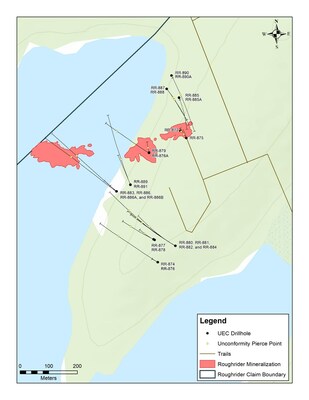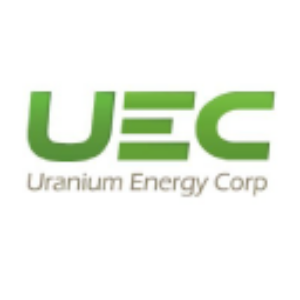NYSE American: UEC
Metallurgical drill hole intersects 3.16% eU3O8 over 43.4 metres
with sub-intervals that grade 4.05% eU3O8 over 12.6 metres and 3.81% eU3O8 over 21.6 metres
CORPUS CHRISTI, Texas, Jan. 31, 2024 /PRNewswire/ - Uranium Energy Corp (NYSE American: UEC), the "Company" or "UEC") is pleased to report drill results from its Roughrider Project located in Northern Saskatchewan, Canada. Both exploration and metallurgical sample drilling have been successful at intersecting uranium mineralization.
- Exploration drilling extends potential of East Zone deposit: UEC commenced a drill program at Roughrider in November 2023 with the dual purpose of exploring for additional resources on the property and for collecting metallurgical samples in the existing resource areas to support future economic studies.
- Discovery of new high-grade vein hosted mineralization in hole RR-889 grading 6.29% eU3O8 over 2.9 metres ("m") ~25 m west of the East Zone deposit ("East Zone"): The mineralization is consistent with the grades and thicknesses of the East Zone and provides targets for resource expansion.
- Metallurgical drill program at Roughrider completed: UEC has completed four metallurgical holes that intersected grades and thicknesses of uranium mineralization consistent with the resource models of the three zones, the best result being hole RR-879, drilled through the East Zone, which graded 3.16% eU3O8 over 43.4 m with sub-intervals grading 4.05% eU3O8 over 12.6 m and 3.81% eU3O8 over 21.6 m (Table 1).
- Roughrider next steps: UEC plans to drill an additional 20 holes comprising about 9,000 m this winter to identify new areas of uranium mineralization. The current resource estimate includes 27.8 million lb U3O8 comprising 389,000 tonnes grading 3.25% U3O8 in the Indicated category and 36.0 million lb U3O8 comprising 359,000 tonnes grading 4.55% U3O8 in the Inferred category1.
Chris Hamel, Vice President Exploration, Canada stated: "Roughrider is a world-class project with untapped potential for resource expansion and we're pleased to confirm this with the discovery of high-grade mineralization between the East and West Zone deposits. The drilling program will continue through the winter and focus on exploration for additional uranium that is outside the existing mineralized zones.
Additionally, our metallurgical drilling has also confirmed the high-grade and vein-hosted nature of the Roughrider deposit with grades and thicknesses consistent with resource modelling and its structural setting. Our competitive advantage is the combination of the foundational work by Hathor and Rio Tinto with the UEC Canada Roughrider Team's proven track record in brownfields resource expansion."
In the below section of this news release, Figure 1 is a map showing the location of drill holes at Roughrider, Figure 2 is a zoom-in of the Roughrider project in the Northern part of Athabasca Basin and Figure 3 illustrates a zoom-out picture of where the Roughrider project is located within the Athabasca Basin.
Drill Hole
|
| From
(m)
| To
(m)
| Width
(m)
| Grade
(%eU3O8)
| Cut-off
(%eU3O8)
| GT
(m*%)
|
RR-875
|
| 225.3
| 245.7
| 20.4
| 0.77
| 0.05
| 15.7
|
incl.
| 234.2
| 243.2
| 9.0
| 1.56
| 1.00
| 14.1
|
| 328.2
| 401.9
| 73.7
| 1.50
| 0.05
| 110.3
|
incl.
| 366.8
| 368.6
| 1.8
| 6.89
| 1.00
| 12.4
|
incl.
| 387.6
| 388.3
| 0.7
| 38.37
| 10.00
| 26.9
|
incl.
| 394.7
| 398.5
| 3.8
| 5.52
| 1.00
| 21.0
|
RR-879
|
| 263.2
| 306.6
| 43.4
| 3.16
| 0.05
| 137.01
|
incl.
| 267.3
| 279.9
| 12.6
| 4.05
| 1.00
| 51.07
|
incl.
| 284.8
| 306.3
| 21.6
| 3.81
| 1.00
| 82.28
|
incl.
| 296.5
| 297.8
| 1.3
| 13.95
| 10.00
| 18.13
|
RR-883
|
| 276.3
| 292.4
| 16.1
| 0.61
| 0.05
| 9.80
|
incl.
| 287.2
| 288.9
| 1.7
| 4.38
| 1.00
| 7.44
|
| 304.8
| 339.7
| 34.9
| 0.78
| 0.05
| 27.13
|
incl.
| 330.2
| 335.2
| 4.9
| 4.46
| 1.00
| 21.84
|
| 342.9
| 358.8
| 15.9
| 0.53
| 0.05
| 8.44
|
incl.
| 354.4
| 358.1
| 3.7
| 1.57
| 1.00
| 5.81
|
RR-885A
|
| 455.4
| 469.5
| 14.1
| 0.18
| 0.05
| 2.50
|
incl.
| 455.7
| 456.2
| 0.5
| 2.08
| 1.00
| 1.04
|
incl.
| 468.6
| 469.1
| 0.5
| 1.90
| 1.00
| 0.95
|
RR-886B
|
| 274.5
| 362.3
| 87.8
| 0.60
| 0.05
| 53.1
|
incl.
| 295.7
| 296.9
| 1.2
| 6.24
| 1.00
| 7.5
|
incl.
| 296.1
| 296.4
| 0.3
| 11.00
| 10.00
| 3.3
|
incl.
| 298.1
| 300.1
| 2.0
| 5.53
| 1.00
| 11.1
|
incl.
| 328.5
| 338.5
| 10.0
| 2.39
| 1.00
| 23.9
|
RR-889
|
| 225.1
| 275.7
| 50.6
| 0.37
| 0.05
| 18.50
|
incl.
| 272.8
| 275.7
| 2.9
| 6.28
| 0.10
| 18.21
|
Table 1: Roughrider Drilling Equivalent Grades
About Canada's Athabasca Basin
The Athabasca Basin is a world-class uranium district in the northern portion of the provinces of Saskatchewan and Alberta in Canada, occupying an area of about 100,000 square kilometres. The unique geology of the Athabasca Basin often results in deposit grades that exceed the world average of uranium deposits of 0.2% U3O8 by up to 100 times.
All of Canada's current uranium production occurs from the mines located in the Athabasca Basin. According to the World Nuclear Association, the Athabasca Basin was responsible for producing 15% of the world's uranium production in 2022.
Uranium mineralization in the Athabasca Basin occurs in fault structures that penetrate the interface between the sandstone and underlying basement rocks. Uranium can be found at the interface, known as the unconformity, or up to several hundreds of metres below the unconformity surface in the underlying basement rock and fault structures.
The uranium concentrations in the holes presented above from the radiometric equivalent uranium grade ("REG"), denoted as eU3O8, were determined in-situ within the drill hole. For more information on REGs please see the "About Radiometric Equivalent Grades" section below.
About Radiometric Equivalent Grades
The eU3O8 grades were estimated in-situ within the drill holes using calibrated down-hole radiometric gamma probes lowered down into the hole. This is a measuring method commonly used by uranium explorers and miners in the Athabasca Basin. The probe records the amount of radioactivity present in the rock adjacent to the probe as it moves up and down the hole.
The standard and shielded probes were calibrated prior to the commencement of the current drill program at the Saskatchewan Research Council's ("SRC") test pit facility in Saskatoon, Saskatchewan, and the Hi-Flux probes are calibrated at Alpha Nuclear in Saskatoon. Using down-hole probes to calculate radiometric equivalent grades is a common practice used by uranium mining companies in the Athabasca Basin. Down-hole probes can accurately measure uranium concentration by measuring the light flashes that occur every time the probe's scintillator is struck by a gamma radiation particle emitted from uranium crystals. The number of light flashes are 'counted' by a photomultiplier tube. Due to a process called 'saturation' that occurs when light emitted by the probe's scintillator overwhelms the photomultiplier tube's ability to 'count' individual light flashes, it can sometimes be difficult to accurately determine radiometric equivalent grades in high-grade intervals.
Samples from all holes have been collected for assay analysis to confirm these equivalent grades. The samples will be analyzed at SRC's Geoanalytical Laboratory in Saskatoon, with results expected in the coming weeks.
About the Roughrider Uranium Project
The Roughrider Project is a uranium project located in the eastern Athabasca Basin of northern Saskatchewan, Canada; one of the world's premier uranium mining jurisdictions. The project is located approximately 13 kilometres west of Orano's McClean Lake Mill, near UEC's existing Athabasca Basin properties. The depth to mineralization at the project is approximately 200 m and hosted primarily in the basement rocks below the unconformity.
Qualified Persons and Data Acquisition
The technical information in this news release has been reviewed and approved by Chris Hamel, P.Geo., UEC's Vice President Exploration, Canada, who is a Qualified Person for the purposes of SEC Regulation S-K 1300.
About Uranium Energy Corp
Uranium Energy Corp is the fastest growing supplier of the fuel for the green energy transition to a low carbon future. UEC is the largest, diversified North American focused uranium company, advancing the next generation of low-cost, environmentally friendly In-Situ Recovery ("ISR") uranium projects in the United States and high-grade conventional projects in Canada. The Company has two production-ready ISR hub and spoke platforms located in South Texas and Wyoming. These two production platforms are anchored by fully operational central processing plants and served by seven U.S. ISR uranium projects with all their major permits in place. Additionally, the Company has diversified uranium holdings including: (1) one of the largest physical uranium portfolios of North American warehoused U3O8; (2) a major equity stake in Uranium Royalty Corp., the only royalty company in the sector; and (3) a Western Hemisphere pipeline of resource stage uranium projects. The Company's operations are managed by professionals with decades of hands-on experience in the key facets of uranium exploration, development and mining.
Stock Exchange Information:
NYSE American: UEC
WKN: AØJDRR
ISN: US916896103
Safe Harbor Statement
Except for the statements of historical fact contained herein, the information presented in this news release constitutes "forward-looking statements" as such term is used in applicable United States and Canadian securities laws. These statements relate to analyses and other information that are based on forecasts of future results, estimates of amounts not yet determinable and assumptions of management. Any other statements that express or involve discussions with respect to predictions, expectations, beliefs, plans, projections, objectives, assumptions or future events or performance (often, but not always, using words or phrases such as "expects" or "does not expect", "is expected", "anticipates" or "does not anticipate", "plans, "estimates" or "intends", or stating that certain actions, events or results "may", "could", "would", "might" or "will" be taken, occur or be achieved) are not statements of historical fact and should be viewed as "forward-looking statements". Such forward looking statements involve known and unknown risks, uncertainties and other factors which may cause the actual results, performance or achievements of the Company to be materially different from any future results, performance or achievements expressed or implied by such forward-looking statements. Such risks and other factors include, among others, the actual results of exploration activities, variations in the underlying assumptions associated with the estimation or realization of mineral resources, the availability of capital to fund programs and the resulting dilution caused by the raising of capital through the sale of shares, accidents, labor disputes and other risks of the mining industry including, without limitation, those associated with the environment, delays in obtaining governmental approvals, permits or financing or in the completion of development or construction activities, title disputes or claims limitations on insurance coverage. Although the Company has attempted to identify important factors that could cause actual actions, events or results to differ materially from those described in forward-looking statements, there may be other factors that cause actions, events or results not to be as anticipated, estimated or intended. Many of these factors are beyond the Company's ability to control or predict. There can be no assurance that such statements will prove to be accurate as actual results and future events could differ materially from those anticipated in such statements. Accordingly, readers should not place undue reliance on forward-looking statements contained in this news release and in any document referred to in this news release. Important factors that may cause actual results to differ materially and that could impact the Company and the statements contained in this news release can be found in the Company's filings with the Securities and Exchange Commission. For forward-looking statements in this news release, the Company claims the protection of the safe harbor for forward-looking statements contained in the Private Securities Litigation Reform Act of 1995. The Company assumes no obligation to update or supplement any forward-looking statements whether as a result of new information, future events or otherwise. This news release shall not constitute an offer to sell or the solicitation of an offer to buy securities.
 View original content to download multimedia:https://www.prnewswire.com/news-releases/uranium-energy-corp-intersects-6-28-eu3o8-over-2-9-metres-in-a-25-metre-step-out-from-the-roughrider-east-zone-deposit-302048776.html
View original content to download multimedia:https://www.prnewswire.com/news-releases/uranium-energy-corp-intersects-6-28-eu3o8-over-2-9-metres-in-a-25-metre-step-out-from-the-roughrider-east-zone-deposit-302048776.html
SOURCE Uranium Energy Corp
![]() View original content to download multimedia:https://www.prnewswire.com/news-releases/uranium-energy-corp-intersects-6-28-eu3o8-over-2-9-metres-in-a-25-metre-step-out-from-the-roughrider-east-zone-deposit-302048776.html
View original content to download multimedia:https://www.prnewswire.com/news-releases/uranium-energy-corp-intersects-6-28-eu3o8-over-2-9-metres-in-a-25-metre-step-out-from-the-roughrider-east-zone-deposit-302048776.html










